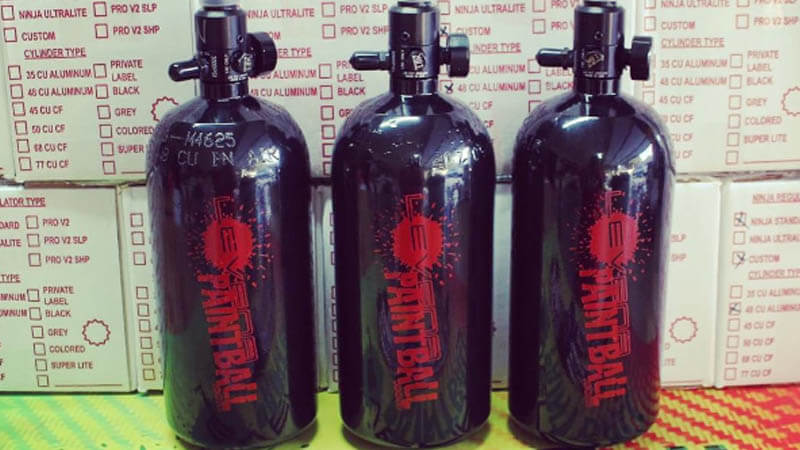HPA tanks are great for airsoft and paintball guns because they allow you to store a lot of air in a small space. But while they’re convenient, they can be a bit tricky to fill up with an air compressor, especially because of the way the valves work, and the risks associated with overfilling.
So, how to fill HPA tank with an air compressor safely and effectively? The key to success is checking the tank’s air pressure, releasing any pressure that may have built up in the tank, and then filling it with the correct amount of pressure with a slow and steady stream from the compressor.
Let’s explore each of the steps to fill an HPA tank with an air compressor in more detail.
Can You Fill an HPA Tank with an Air Compressor?
Yes, you can. However, a typical home air compressor might not have enough pressure to fill an HPA tank. The average home air compressor has a PSI of about 120, which isn’t enough to fill an HPA tank adequately. You need an air compressor that has a PSI of at least 850.
Additionally, you should check the CFM or cubic feet per minute. This is a measure of how much air the compressor can deliver in a minute, and you need a CFM of at least 3.0 to fill an HPA tank properly.
What You Need to Fill an HPA Tank with an Air Compressor
To fill an HPA tank with an air compressor, you’ll need to ensure you have the right equipment. This includes:
- High-pressure air compressor with a PSI of at least 850 (or according to the HPA tank’s specific requirements)
- The HPA tank
- Fill station or adapter that connects the air compressor to the HPA tank
- An anti-siphon device (this is optional but recommended)
- High-pressure air hose and nozzle with the proper fit
How to Fill HPA Tank with Air Compressor: Step-by-Step Procedure
Once you have all the equipment, you’re ready to fill your HPA tank. Be sure to wear safety glasses before going ahead with the steps below.
Step 1: Check the Tank’s Air Pressure
The first thing you need to do is check the tank’s air pressure with its pressure gauge. Take note of the PSI so you know how much air to add. Most HPA tanks have a maximum pressure of 850 PSI, but it’s always best to check your specific tank’s limit.
Also, check for any leaky valves by placing your finger over the valve and then slowly releasing the pressure. If there’s a leak, you’ll feel air escaping from around your finger. This is important because any leak or damage can lead to an explosion while filling the air in.
Step 2: Release the Air in the Tank
If there’s any pressure build-up in the tank, release it before proceeding to the next step. To do this, open the valve and let the air out until the pressure gauge reads 0 PSI. Essentially, you’ll want to do this in a well-ventilated area so the air can disperse.
Step 3: Connect the Air Compressor
Next, you’ll need to connect the air compressor to the HPA tank using the fill station or adapter. If you’re using an adapter, make sure it’s the right size for your specific tank. Take the hose from the air compressor and connect it to the adapter or the fill station with the nozzle.
Step 4: Slowly Fill the Tank with Air
Once it’s connected, turn on the air compressor. Now, you can start filling the tank with air. Slowly open up the valve and let the air in until the pressure gauge reaches the desired PSI. Be sure to fill it slowly because filling it too quickly can disrupt the pressure balance and cause the tank to malfunction.
If you’re using an anti-siphon device on the end of the hose, be sure to open the valve on that as well. This will help prevent any liquid from getting into the tank and ruining it.
Step 5: Monitor the PSI while Filling
As you’re filling the tank with air, regularly check the PSI using the pressure gauge. This way, you can monitor the amount of air going into the tank and prevent it from becoming overfilled.
Step 6: Close the Valve and Turn Off the Compressor
Once the tank has reached the desired PSI, close the valve and turn off the compressor. You can now disconnect the hose from the fill station or adapter by taking the nozzle off. Also, be sure to close the valve on the anti-siphon device if you’re using one.
Step 7: Check for Leaks
Even if you didn’t find any leaks before, it’s always a good idea to check again after filling the tank. This is because the high pressure can sometimes cause leaks that weren’t there before. You can do this the same way you did in step one.
Additional Tips for Filling an HPA Tank with an Air Compressor
Now that you know how to fill an HPA tank with an air compressor, there are a few additional tips to keep in mind for safety:
- Avoid putting grease or oil on the O-rings or other parts of the tank. This can cause deterioration and swelling, which can lead to leaks.
- If you’re using an adapter, make sure it’s the right size for your specific tank.
- Be sure to always have a safety valve open when filling the tank so you can release any pressure that builds up.
- Never overfill the tank. This can cause the tank to explode, which can be extremely dangerous.
- If you’re not using a regulator, be sure to stop filling the tank when the pressure gauge reaches 850 PSI.
- Avoid storing the tank under direct sunlight or in extreme temperatures as this can damage the tank’s regulator seals.
FAQ
Below, we have answered some of the most frequently asked questions about filling an HPA tank with an air compressor:
No, you need to use a specifically designed air compressor that can fill the tank up to 4500 PSI. The air compressor needs to be heavy-duty and have a regulator so you can fill the tank slowly and evenly.
An HPA tank is filled with compressed air, while a CO2 tank is filled with carbon dioxide. HPA tanks are generally considered to be better for paintball guns due to their consistent airflow, which leads to more accurate shots.
Yes, it’s not recommended to fill an HPA tank with lower air pressure. This is because the pressure inside the tank needs to be balanced in order for it to work properly. If the pressure is too low, the tank may not function properly and could even explode.
No, compressed air is not recommended for filling an HPA tank. This is because the pressure inside the tank needs to be regulated in order to prevent it from exploding. Compressed air doesn’t have a regulator, so it’s not safe to use.
Conclusion
Filling your HPA tank with an air compressor is an essential part of paintballing, so it’s important you know how to do it correctly. And hopefully, after reading this article, you now feel confident enough to do so.
As you can see, filling an HPA tank with an air compressor should be a fairly straightforward process as long as you follow the instructions carefully and don’t rush it. Additionally, take note of the extra safety tips provided to make sure you fill the tank safely and without any issues.

